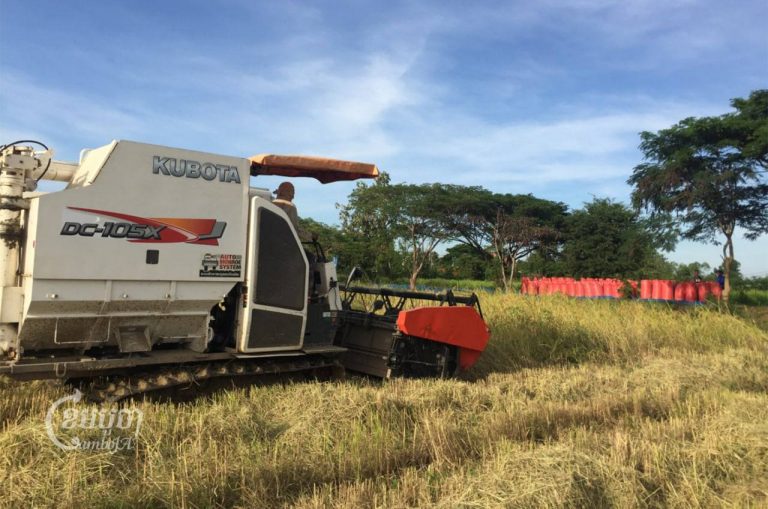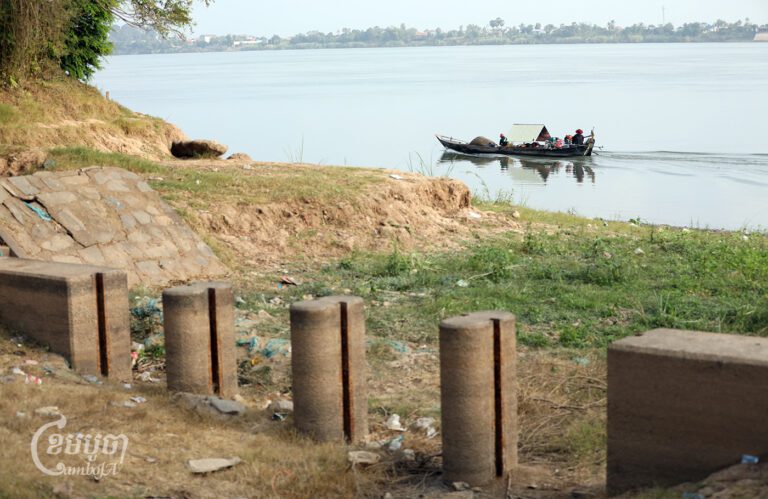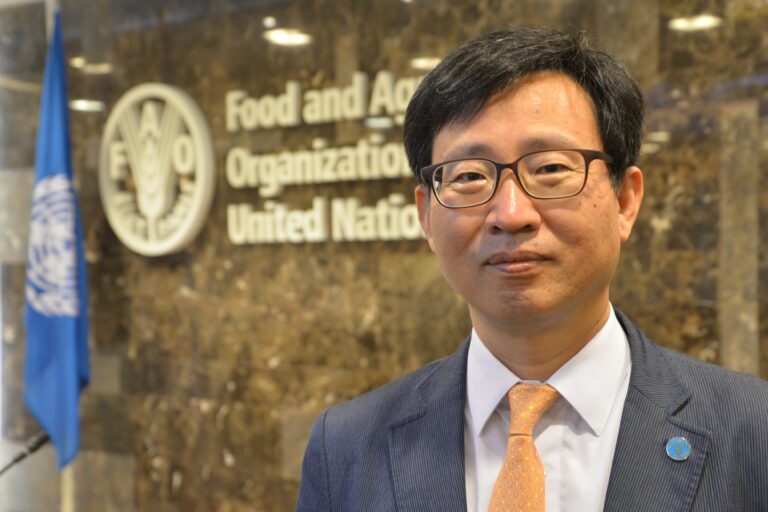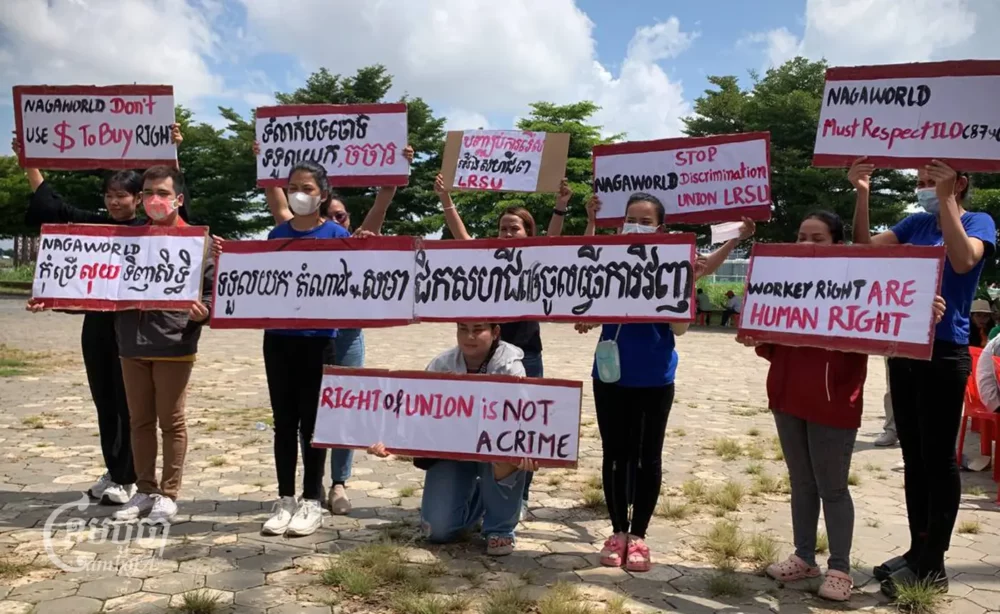At least 760,000 hectares of dryland rice are planted in a few provinces, however, there is currently a scarcity of water to irrigate their fields, which is worrying farmers as they could fall deeper into debt.
While authorities claim they are making every effort to resolve the matter, over 200 farmers in Takeo province protested, blocking the road on Friday in a bid to demand for the release of water from the reservoir for their fields. Dryland paddy is a variety of rice cultivation, which is planted on floodplains after the water has receded.
Among them, Khim Sophoan from Pursat province, Bakan district, said the lack of irrigation water resulted in the “complete destruction” of two hectares of rice fields and another two hectares on the verge of destruction, despite being near a canal. “There was no water to pump from the canal.”
Although Cambodia has rivers, streams and lakes, farmers continue to face water shortages for agriculture. If the government does not have an abundant irrigation system, farmers will face difficulties, she said.
Her capital for farming comprised bank loans and private loans but with her rice fields completely damaged, she is facing serious debt problems.
“The two hectares will be destroyed if we do not get a drop of water. One hectare costs almost five million riel. Shortage of water has been a recurring issue since I started farming.
“Because the Ministry of Water Resources and Meteorology (MOWRAM) hasn’t prepared a good water system for us, I lost $2,500. I can’t do anything but wait for water near the canal,” the 39-year-old said.
She blamed the authorities for not intervening and responding to farmers’ needs, as water shortages occur every year, yet there has been no effective solution. The authorities should not blame farmers for “over-farming” when there is a lack of water, instead they should find ways to resolve the problem and create awareness about climate change and the risks.
“I don’t know how he [ministry] plans the water system but, whenever I start dry farming, there is always a water shortage. If you do more, you lose more. If you do less, you lose less,” said Sophoan.
Her concern is the lack of money to support her family and children’s education. The ministry should have shared information with the people from the beginning, she said. “So, if we continue to farm, we are wrong.”
Another farmer in Battambang province, Hoeun, 70, said he does not know if he should blame the government as there is neither water nor rain to irrigate the fields. The government should build more irrigation systems to meet the needs of farmers though, he added.
“I lost around 400,000 riel after one hectare of my fields was damaged. The government needs to make more effort to build additional water systems,” said Hoeun.
At a Council of Ministers’ plenary meeting on February 2 at the Peace Palace, Prime Minister Hun Manet instructed the Ministry of Agriculture, Forestry and Fisheries (MAFF), the National Committee for Disaster Management and other relevant institutions to be ready to address water shortages.
He also urged the relevant officials to check and restore the irrigation system.
Pursat provincial governor Khuy Rida told CamboJA that provincial authorities and relevant ministries were doing their best to resolve water shortages for dryland rice farmers.
He said despite the authorities’ announcement of water shortages, people are “still rushing to grow more rice than planned”.
“Our provincial and district authorities have done their best and we supply water based on the reservoir [reserve],” Rida mentioned. “Currently, water is being pumped into the main canal, but the amount does not meet [their] needs.”
Responding to the lack of water for dry season rice farming, he said it is because people know that the price of rice this year is better than last year. As such, people are rushing to do rice farming, which has resulted in a water shortage.
“In the dry season, we do not have adequate sources of water for dry rice farms. However, some people noticed the price of rice [this year], so they [want to] do it again. Our authorities informed them [of the inadequate supply], but they didn’t listen,” he said. “We are very sorry for their losses. We do intervene if there is a water shortage, but when there is no water, how can we intervene?”

In Pursat province, there are nearly 50,000 hectares of dryland farmers, but the water source amounting to 60 million cubic meters can only cover 20,000 hectares of dryland rice. The districts that face this problem are Kandieng and Bakan.
To meet the agricultural demand, the government plans to construct the second phase of Pursat river to prevent water shortage for dryland farming in the future.
“We will keep working on it [building an irrigation system]. Once the river is built, people will be able to farm freely because it can store 800 million cubic meters of water,” he said.
Meanwhile, the 200-over residents in Samrong and Prey Kabbas districts in Takeo province, who organized the protest, demanded the Samrong authority to release water from the upstream segment of Boeung Bort Rokar to irrigate their dryland rice.
Keth Mao, Samrong district governor, told CamboJA that water shortages never happened previously because every year the authorities informed the people not to cultivate dryland rice. This year, rice prices soared, prompting people to increase dry rice cultivation compared to the previous year.
He said the authorities have already informed the provincial governor and would send experts to check the water level in Boeung Bort Rokar and visit people’s dryland rice.
Water from the upstream region is only supplied to people in Samrong for daily consumption while the downstream water is for farmers. However, he added that the water downstream is starting to run out.
On Friday afternoon, experts visited the site to check the water level in the lake reservoir as well as the people’s rice fields to see how much water should be released, but there has been no update yet.
Amid this, he stressed that there is insufficient water in the reservoir. “If we open the reservoir for three days, it may run out of water. If that happens, it will affect nine communes in Samrong district that use it. We don’t know where we can get [more] water for the people.”
Assuming the water from the reservoir is released and fails to provide sufficient supply for dryland rice and households for personal consumption, the authorities would look for another solution.
“The amount of water is only sufficient until April, but if you turn on the water for dryland rice [farming], it will run out by early March.”
Kong Sreyleap, a citizen at Samrong district, told CamboJA that she is concerned about the authorities releasing the water for dryland rice because it is “very hot this year and the dry season is long”.
If the water runs out, the risk is very high. Citizens in Samrong district have previously faced water shortage for daily use.
“I don’t want the authorities to open the water for dryland farming as the people in Samrong district need to use the water from the lake as well,” she said. “If it’s open, we will be much affected, especially those who do not have wells. There will be a shortage of water supply for the people.”
Agriculture Ministry spokesperson Khim Finan told CamboJA that the lack of water for dryland farming this year was “not a natural disaster”. Rather, the majority of farmers are carrying out dry rice field farming beyond the water management plan, for example in Battambang and Pursat province.
“This damage does not affect the overall yield of dry season rice,” he said. “The government always has a response, but the response depends on the situation.”
Finan remarked that although there has been a shortage of water this year, the yield for dry rice has not decreased.
In addition, he said, most of the damaged areas were due to the fact that those areas are not cultivated for dryland farming and that it has “always been at risk”. In fact, the place that farmers cultivate every year does not have any risk factor in terms of damage.
Chan Yutha, spokesperson for MOWRAM, said according to the 2023-2024 irrigation plan for rice cultivation in the dry season, only 500,000 hectares will be implemented. But, as of February, the dryland area is about 760,000 hectares this year, which is “unprecedented” compared to last year.
Yutha said the increase in rice production during the dry season is the reason for the water shortage. Nevertheless, the ministry has intervened “as far as possible” to secure water sources for farmers.
“Most of the affected areas are already being tackled. The figure would be added by the end of the year,” Yutha told CamboJA. “In some places, as long as there are water sources, we try our best, except where there aren’t any.”
An announcement by MOWRAM stated that from February to early May 2024, the temperature would rise gradually, increasing sharply to 38 degrees Celsius between April and early May. Some days, it might hit 41 degrees Celsius. With rising temperatures, rainfall might be lower than in 2023, and there could be more thunderstorms and gales.
Yutha added that last year, Cambodia recorded 600,000 hectares of dryland rice. Back in 1999 and 2000, there were only 250,000 hectares.
“These places were never dry [or] never ran out of water from the lake, but now we see a change, so we are responding to that change,” he said.
In light of this, president of the Coalition of Cambodian Farmers Community Association (CCFC) Theng Savoeun believed that the stakeholders’ response mechanism should be to the actual situation. But, it has yet to find a suitable solution for the people.
“Farmers, who are dry season rice farmers, are still victims. Their livelihood is impacted as they continue to fall into debt. Lots of money is used to cultivate rice farms,” he said.
The irrigation system in Cambodia has not met the needs of farmers, hence why ministries including MOWRAM, MAFF, Public Works and Transportation, and Rural Development are working together to do just that.
“Farmers don’t grow enough dry rice. If all of them grow rice like in the rainy season, I think the problem will expand due to water shortages,” he said.














